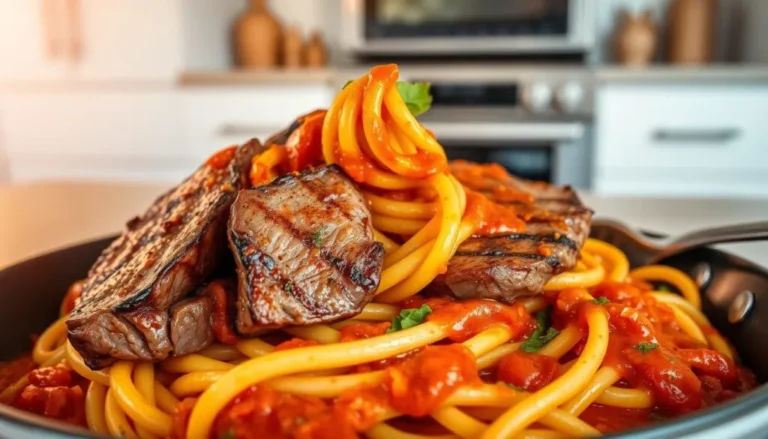Just Meats : 7 Best Ways to Grill Juicy Burgers
Table of Contents
Summer memories come alive with the sound of burgers sizzling on the grill. Every backyard barbecue is a story of flavor, tradition, and connection. Whether you love just meats or plant-based options, making the perfect burger is an art.
Grilling is more than just cooking food. It’s about making memories. Your journey to the ultimate burger starts here. We’ll explore the science and passion behind grilling, from vegan proteins to classic beef.
Key Takeaways
- Master the essential fat-to-lean meat ratio for juicy burgers
- Understand temperature control for perfect doneness
- Learn techniques to preserve burger moisture
- Explore diverse protein options beyond traditional beef
- Discover professional grilling methods that guarantee flavor
Understanding the Perfect Burger Basics
Making the ultimate burger is more than just grilling meat. It’s about knowing the key basics that turn a simple patty into a work of art. Whether you’re making traditional beef burgers or trying meat alternatives, getting these basics right will take your grilling to the next level.
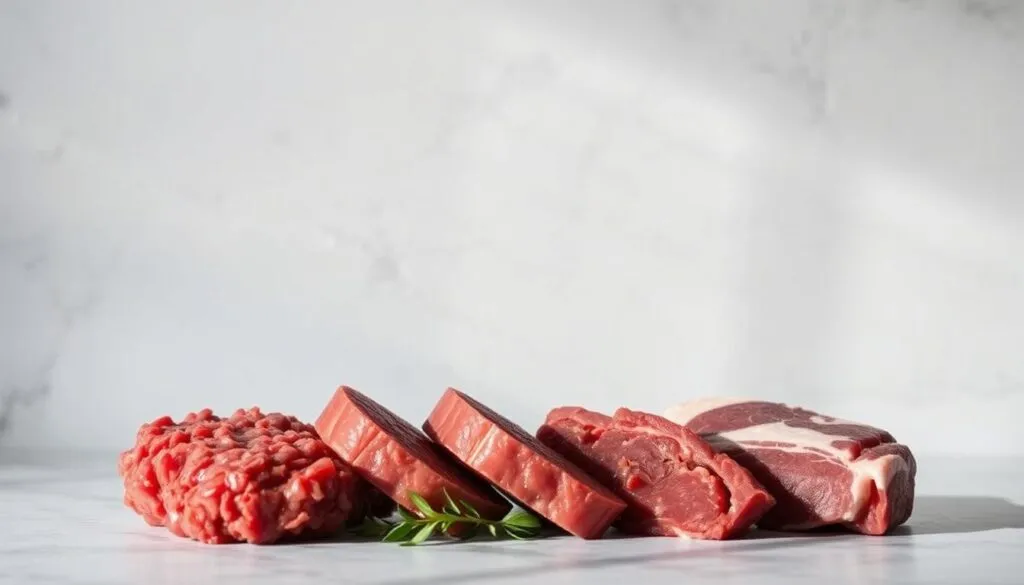
Optimal Fat-to-Lean Meat Ratio
The secret to a juicy burger is its fat content. For both meat substitutes and traditional ground beef, the right fat-to-lean ratio is key. Chefs say an 80/20 blend – 80% lean meat and 20% fat – is the best for both meatless and traditional burgers.
| Meat Type | Fat Percentage | Burger Characteristics |
|---|---|---|
| 90/10 Lean Ground Beef | 10% | Healthier but potentially dry |
| 80/20 Ground Beef | 20% | Juicy, flavorful standard |
| 70/30 Ground Beef | 30% | Very rich, potential greasiness |
Importance of Meat Temperature
Temperature is crucial in burger making. Both meat substitutes and ground beef need careful temperature control. Cold meat helps keep patties together, preventing them from falling apart while cooking.
- Keep meat refrigerated until preparation
- Handle meat minimally to prevent toughness
- Use cold hands or gloves when forming patties
Selecting Quality Ground Beef
When picking ground beef or meat substitutes, choose high-quality options. Fresh, top-notch meat means better taste and texture. Look for meat with visible marbling and a bright, consistent color. For meat alternatives, pick plant-based options with similar fat content and binding properties.
Pro tip: Whether using beef or meatless burgers, the key is finding the right balance of fat, flavor, and moisture.
Essential Equipment for Grilling Success
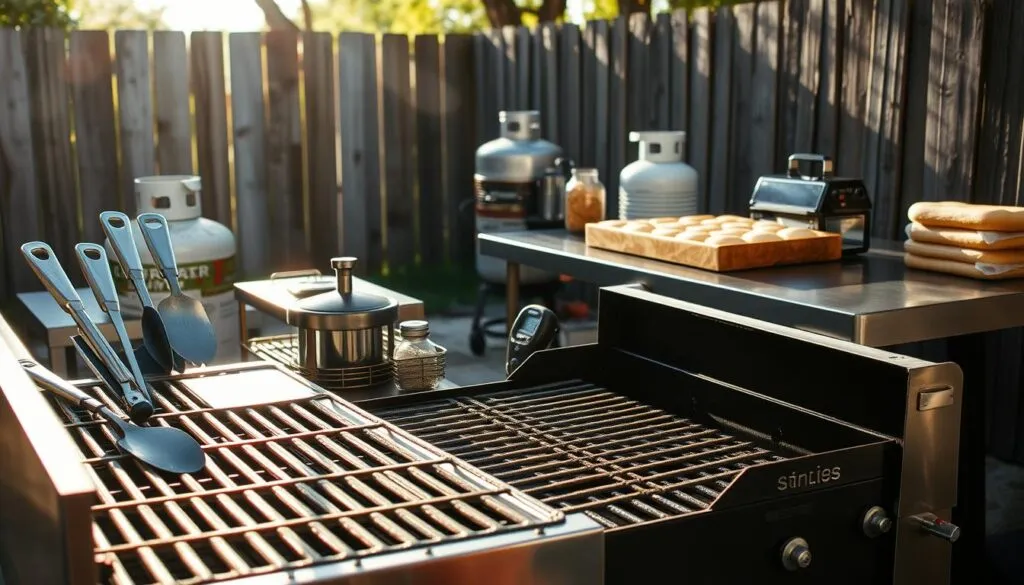
Grilling the perfect burger is not just about skill. It also needs the right tools. Whether you’re making traditional meat patties or trying veggie patties and soy-based products, top-notch equipment makes a big difference.
Your grill arsenal should have several key items. These ensure precision and quality:
- A reliable meat thermometer for perfect temperature control
- Long-handled stainless steel tongs for safe food handling
- High-quality spatulas with wide, flexible blades
- Heat-resistant gloves for protection
- Non-porous cutting boards for food prep
Digital probe thermometers are a big help for both meat and veggie patties. They give you instant readings. This helps you get the perfect doneness without guessing. When grilling soy-based products, it’s even more important to control the temperature. This prevents burning or undercooking.
“The right tools can elevate your grilling from good to extraordinary.”
Investing in quality grilling accessories is a smart move. Things like chimney starters, silicone BBQ brushes, and grill baskets can really improve your cooking. These tools make grilling easier and help you make meals that taste like they’re from a restaurant.
Don’t forget to take care when grilling veggie patties. Specialized grill baskets and careful temperature control are key. They make sure your plant-based options are just as tasty as traditional burgers.
Just Meats Guide to Burger Preparation
Making the perfect burger needs skill, technique, and knowing how to handle meat. Whether you’re grilling beef patties or trying seitan or jackfruit, getting good at making burgers is essential. It’s the key to a delicious meal.
Proper Patty Formation
To make the best burger patty, start with the right meat. For beef, go for an 80/20 lean-to-fat ratio for juiciness. Here’s how to form patties perfectly:
- Use cold hands to prevent meat from warming up
- Gently shape patties without overworking the meat
- Create a slight dimple in the center to prevent bulging
- Keep patties uniform in thickness (about ¼ lb each)
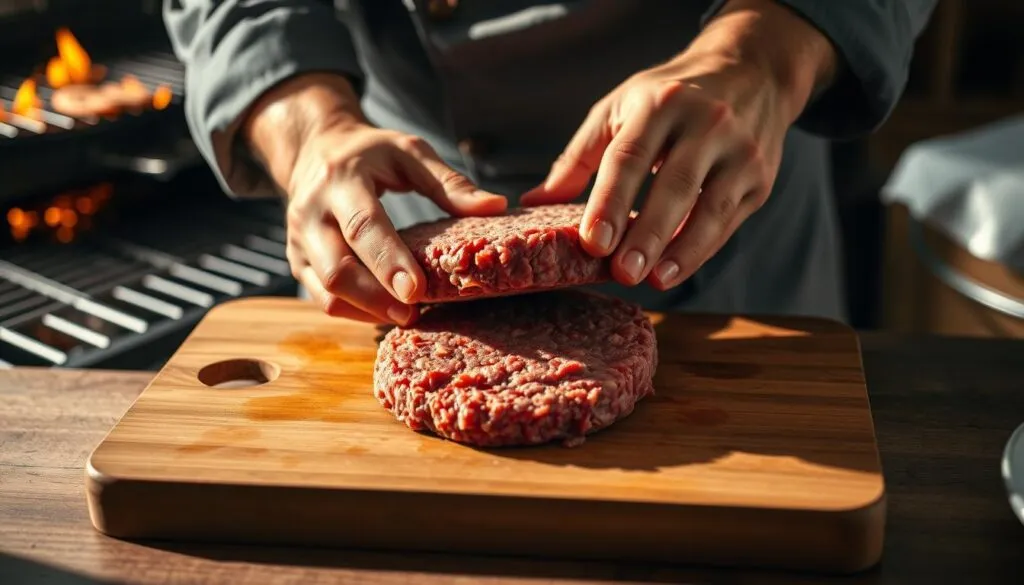
Seasoning Techniques
Boost your burger’s taste with smart seasoning. Even with seitan or jackfruit, traditional seasoning is key:
- Season meat just before cooking
- Use kosher salt and freshly ground black pepper
- Add 1 tablespoon of beef bouillon for depth
- Incorporate dried minced onion for extra flavor
“The secret to a great burger is in the seasoning and handling,” says renowned pitmaster Matt Abdoo.
Temperature Control Methods
Controlling the temperature is crucial for the right burger doneness. The USDA says to cook ground meat to 160°F for safety. Use an instant-read thermometer for exactness:
- Rare: 120°F-125°F
- Medium Rare: 130°F-135°F
- Medium: 140°F-145°F
- Medium Well: 150°F-155°F
- Well Done: 160°F
Pro tip: The Typhur InstaProbe Core thermometer offers lightning-fast 0.5-second readings with ±0.5°F accuracy, ensuring perfect results every time.
The Science Behind Juicy Burgers
To make juicy just meats burgers, we need to know about meat and cooking. Beef is made of proteins, water, and fat. These change a lot when cooked.
The secret to a great burger is in its molecules. When you grill meat, amazing things happen:
- Protein fibers start to break down
- Water molecules move around
- Fat melts, adding flavor
The Maillard reaction is key for burgers. It makes most of the meat’s taste. This happens when proteins and sugars meet high heat.
“Great burgers are a delicate balance of science and culinary art.”
Plant-based meats work differently but aim for juiciness too. They use proteins and oils from plants instead of fat.
| Burger Component | Contribution to Experience |
|---|---|
| Aroma | 30% |
| Texture | 25% |
| Presentation | 15% |
| Sound | 15% |
| Taste | 15% |
To make the perfect burger, you need to know these science facts. This is true for both traditional and plant-based burgers.
Secret Ingredients for Enhanced Moisture
Making the perfect burger is more than just picking good meat. You need special techniques to keep it moist. This makes every bite a delight that people love to have again.
Top chefs know that moisture is key for a great burger. It doesn’t matter if you use beef or try vegan options. The right method can make your burgers amazing.
Ice Water Integration Method
Ice water is a secret for juicy burgers. Adding 2-3 tablespoons of ice-cold water per pound of meat makes a big difference. This trick works for all kinds of proteins:
- Traditional ground beef
- Ground turkey
- Vegan proteins
- Plant-based meat alternatives
Fat Distribution Techniques
How you mix fat into your burgers is very important. Here are some expert tips:
- Mix ingredients gently to avoid squishing the meat
- Make a small dent in the middle of each patty
- Use meat that’s at room temperature for better cooking
For those who like to try new things, adding special ingredients can help. A bit of vegetable broth or olive oil can make plant-based burgers extra moist.
Mastering Grill Temperature Zones
Grilling the perfect burger starts with knowing your grill’s temperature zones. Whether you’re making traditional beef patties or trying meatless burgers, controlling the heat is key. This ensures your burgers turn out delicious.
The two-zone method is a must for grill masters. It involves setting up two different heat areas on your grill:
- High Heat Zone: 450°F to 550°F – ideal for searing
- Medium Heat Zone: 350°F to 450°F – perfect for even cooking
- Low Heat Zone: 250°F to 350°F – great for finishing and preventing overcooking
When grilling, start by searing your patties on the high-heat zone. This creates a tasty crust. Then, quickly move them to the lower-temperature area to finish cooking without burning.
| Grill Zone | Temperature Range | Best For |
|---|---|---|
| High Heat Zone | 450-550°F | Searing burgers, steaks |
| Medium Heat Zone | 350-450°F | Cooking meatless burgers, vegetables |
| Low Heat Zone | 250-350°F | Finishing cooking, preventing burning |
Pro tip for grilling meat substitutes: These plant-based options need gentle heat. Use your medium and low heat zones to avoid burning and ensure they’re heated through.
Remember, grill temperature control is an art that transforms good burgers into great ones!
Proper Burger Handling Techniques
Mastering burger preparation is more than just grilling meat. It’s about handling beef patties, veggie patties, and soy-based products right. This is key for tasty results.
Flipping Methods: The Key to Perfect Burgers
Grilling success comes from knowing how to flip burgers right. Here are mistakes to avoid:
- Never press burgers with a spatula – this squeezes out precious juices
- Flip only once during cooking to maintain moisture
- Use a flat, wide spatula for clean, even flipping
Common Grilling Mistakes to Avoid
Cooking burgers needs precision, especially with different proteins. Here’s a quick guide to avoid common errors:
| Protein Type | Key Handling Tips |
|---|---|
| Beef Patties | Create 1/2-inch indent to prevent puffing |
| Veggie Patties | Handle gently to prevent crumbling |
| Soy-based Products | Lower heat to prevent burning |
Remember, different proteins need different handling. Soy-based products and veggie patties are more delicate. They need gentler treatment than traditional meat burgers.
“The secret to great burgers is not just in the meat, but in how you handle it.” – Grill Master Pro
Timing and Temperature Guidelines
Getting the burger temperature right is key for taste and safety. An instant-read thermometer is your go-to for grilling. It helps your burgers cook perfectly and safely.
Different meats need different temperatures. Here’s a quick guide for beef burgers:
- Rare: 120°F – 125°F
- Medium-Rare: 130°F – 135°F
- Medium: 140°F – 145°F
- Medium-Well: 150°F – 155°F
- Well-Done: 160°F and above
For seitan and jackfruit, the rules are different. These plant-based foods need to be heated well for safety and texture.
| Protein Type | Safe Internal Temperature | Recommended Cooking Method |
|---|---|---|
| Ground Beef | 160°F | Direct grill, medium-high heat |
| Seitan Delicacies | 165°F | Grill or pan-sear |
| Jackfruit Jerky | 165°F | Indirect heat, careful monitoring |
Pro tip: Always insert your thermometer through the side of the burger for the most accurate reading.
“Temperature accuracy is the key to a perfectly cooked burger every single time.” – Grill Masters Cookbook
Food safety is always first. The USDA says to cook ground meats to 160°F. This kills harmful bacteria and makes your meal safe and tasty.
Professional Grilling Techniques
Mastering just meats grilling means learning advanced techniques. These techniques take your burger game to the next level. Professional chefs know the secret is balancing heat methods to create perfectly cooked burgers that satisfy every palate.
Grilling is more than just throwing meat on a hot surface. It’s an art that requires precision, knowledge, and skill. Whether you’re working with traditional just meats or exploring plant-based meats, understanding heat application is crucial.
Indirect Heat Method
The indirect heat method allows for gentle, even cooking. It prevents burning and maintains moisture. This technique works brilliantly for:
- Thicker burger patties
- Preventing exterior charring
- Ensuring consistent internal temperature
When using indirect heat, place your burgers away from direct flame. This approach works exceptionally well for plant-based meats, which can dry out quickly.
Direct Heat Application
Direct heat creates that delicious, crispy exterior that burger lovers crave. Key strategies include:
- Preheat grill to high temperature (around 400-450°F)
- Create distinct temperature zones
- Sear burgers quickly for beautiful grill marks
Professional grillers recommend a combination of both indirect and direct heat methods to achieve burger perfection. This approach works seamlessly with both just meats and plant-based alternatives.
Pro tip: Always let your meat rest for 3-5 minutes after grilling to retain maximum juiciness.
Creating the Perfect Burger Crust
Making a great burger crust is like an art. It turns a simple patty into a feast for the taste buds. Whether you use traditional beef or try vegan options, the trick is to know about browning.
The magic happens with the Maillard reaction. This process changes proteins and sugars into tasty compounds when heated high. For meat, aim for 250°F to get that perfect crust.
- Preheat your grill or skillet to high heat
- Pat meat or vegan proteins dry before cooking
- Avoid moving the patty too much during initial cooking
- Use a cast-iron surface for maximum browning
Vegan proteins can also get a great crust. Just make sure they’re dry and cook them at high heat. Tofu, seitan, and plant-based patties work well with pressing out moisture and cooking hot.
“A perfect crust is the hallmark of a truly great burger, regardless of its protein source.” – Grilling Experts
Pro tip: For meat burgers, pick ground beef with 15-20% fat. For vegan options, choose ones that can handle high heat. This way, you get a burger with a crispy outside and juicy inside.
Resting and Serving Tips
Perfecting your burger isn’t just about grilling. The final steps of resting and serving are key for maximum flavor and juiciness. Whether you’re cooking traditional meat burgers or trying meatless burgers and substitutes, knowing how to rest them can make a big difference.
The moments after removing your burger from the grill are very important. Carryover cooking keeps changing the internal temperature. This makes resting essential for spreading out meat juices evenly.
Optimal Resting Time
Professional grill masters suggest specific resting times based on burger thickness:
- Thin burgers (¼ inch): 3-4 minutes
- Medium burgers (½ inch): 5-6 minutes
- Thick burgers (¾ inch): 7-8 minutes
Serving Temperature Recommendations
For meatless burgers and traditional meat substitutes, follow these temperature guidelines:
| Burger Type | Ideal Resting Temp | Serving Temp Range |
|---|---|---|
| Beef Burgers | 130-140°F | 135-145°F |
| Plant-Based Burgers | 125-135°F | 130-140°F |
“Let your burger rest, and it will reward you with incredible flavor and juiciness.” – Grill Master’s Secret
Remember to put your burger on a warm plate and loosely cover with foil during resting. This keeps the heat in and lets juices spread out. You’ll get a juicy bite every time.
Conclusion
Your burger grilling adventure goes beyond just meat patties. You can try classic beef burgers or veggie patties. Each method helps you make tasty, juicy burgers for everyone.
Soy-based products are a great choice for those who want plant-based burgers. By using the right temperature, seasoning, and prep, you can make any patty delicious. Great grilling is about knowing your ingredients and mastering your technique.
Your journey is just starting. Keep trying new meats and plant-based options. Improve your skills and enjoy the process. Soon, you’ll make burgers that impress everyone.
Every burger you grill makes you better at grilling. Keep learning, trust yourself, and enjoy the tasty results of your creativity.
FAQ
What is the ideal fat-to-lean meat ratio for juicy burgers?
For juicy burgers, aim for an 80/20 ratio of lean meat to fat. This mix keeps your patties moist and tasty without being too greasy.
How do I prevent my burgers from falling apart on the grill?
Make sure your patties are firm and chilled before grilling. Don’t overhandle the meat. Create a slight dimple in the center to stop them from puffing up.
For plant-based meats, use a firmer binding technique and handle with extra care.
What’s the best way to tell if my burger is cooked properly?
Always use a meat thermometer for accuracy. Beef burgers should be cooked to 160°F. For meat alternatives, follow the package’s specific cooking instructions.
Can I use the same grilling techniques for meat and plant-based burgers?
While similar, plant-based meats need slight adjustments. Soy-based products and seitan require lower heat and less cooking time. Always adjust your grilling approach based on the specific protein you’re cooking.
How do I keep my burgers moist when grilling?
Use the ice water method to retain moisture. Avoid pressing down on the patties while cooking. Don’t overcook. For meat burgers, maintain an 80/20 fat ratio. For vegan proteins, consider marinating or adding moisture-rich ingredients to prevent dryness.
What’s the best way to season burger patties?
Season your meat patties generously with salt and pepper just before grilling. For added flavor, experiment with just meats seasoning blends or herbs. With meat alternatives, be cautious about salt content and consider using marinades or dry rubs that complement the base protein.
How long should I let my burgers rest after grilling?
Let your burgers rest for 5-10 minutes after cooking. This allows the juices to redistribute, ensuring a more flavorful and moist burger. For meat alternatives, follow the specific resting guidelines provided by the manufacturer.

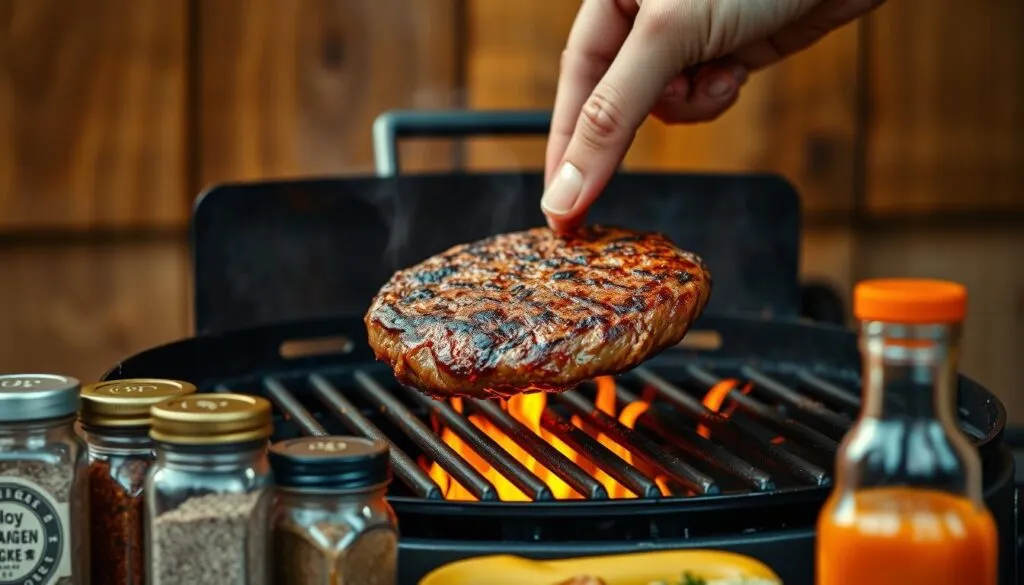
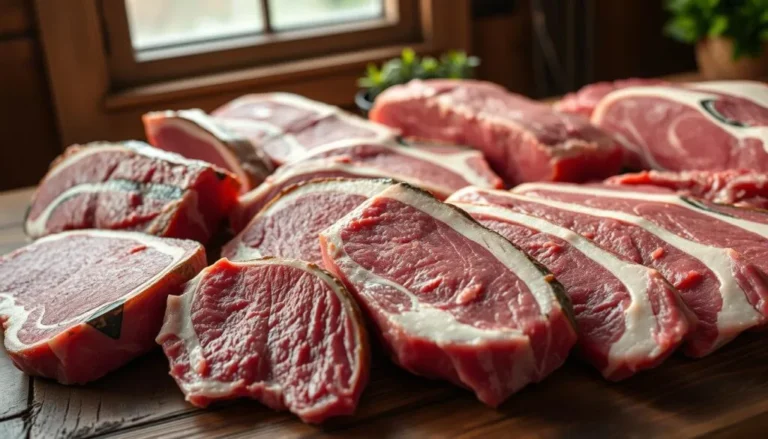
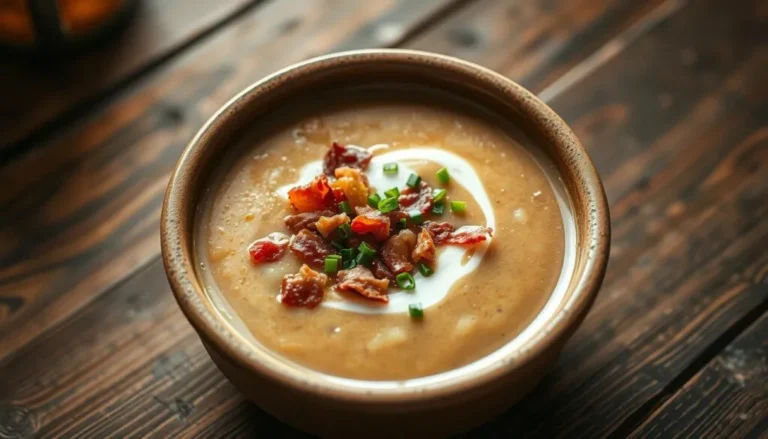
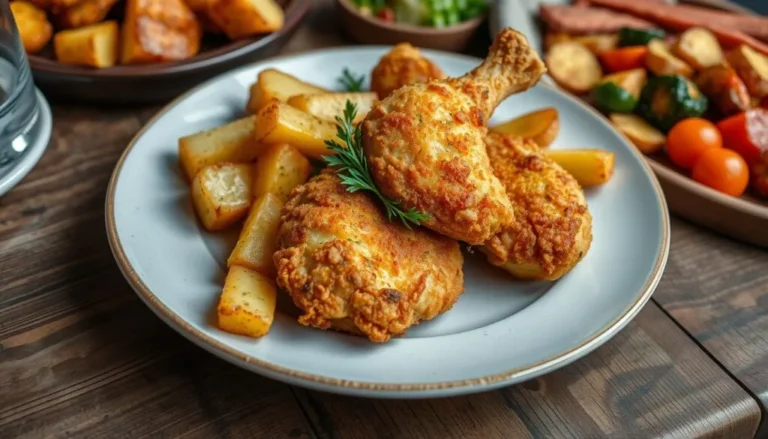
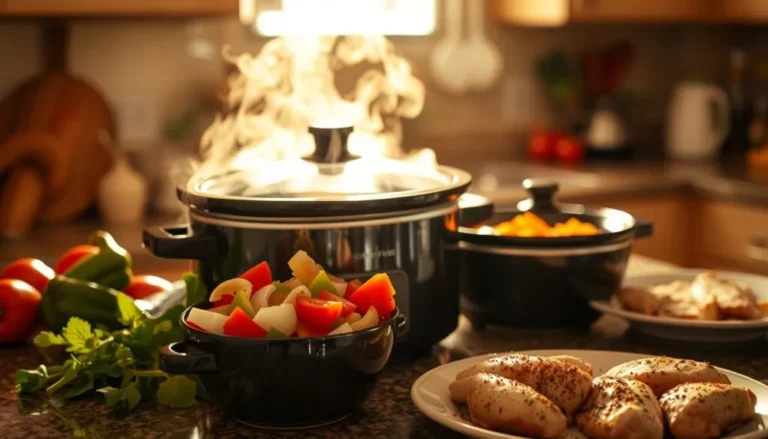
![Burger Sauce Recipe]](https://www.recipesadam.com/wp-content/uploads/2024/12/Burger-Sauce-Recipe-768x439.webp)
